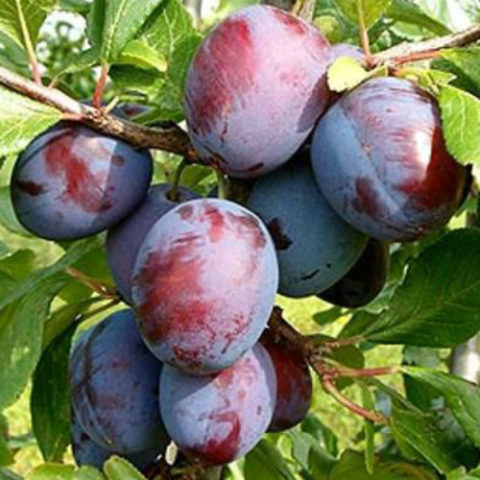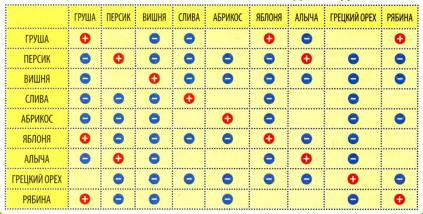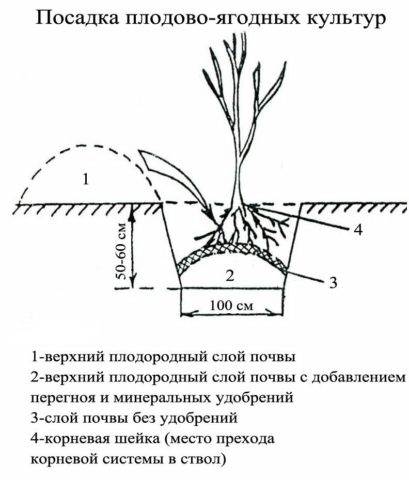Content
Plum Kabardinka is one of the most popular varieties of crops grown in warm regions of the country. It is appreciated for its good yields of fruits with excellent sweet taste. In addition, it is considered one of the proven self-fertile varieties of plum, producing large purple fruits.
Breeding history of the variety
The Kabardinskaya early plum variety was obtained at the North Caucasian Research Institute of Horticulture in the city of Nalchik by accidental pollination of Anna Shpet plum. Kabardinka has been included in the State Register since 1959 and is recommended for cultivation in the North Caucasus region.
Description of plum variety Kabardinskaya early
The Kabardinka variety belongs to the home plum type. The tree is characterized by rapid growth and reaches a height of 6 m. The crown is compressed, pyramidal in shape, its diameter is no more than 3 m with densely arranged branches. Oval-shaped leaf plates with pointed, elongated ones.
The fruits grow large, the weight of one is 40-50 g. The main color of the skin is purple, there is a barely noticeable waxy bloom and almost indistinguishable white specks. The shape of the plum is round, the seam is weak. Under the dark, dense skin, there is a bright orange pulp, which quickly turns brown when cut. The pulp is characterized by juiciness, medium density and unusually sweet taste with a pleasant sourness. The tasting score of Kabardinka is 4.5-4.9 points out of 5, other early-ripening varieties of plums cannot boast of such fruit taste.
Kabardian early is grown in warm regions of the country, which include the Stavropol Territory, Adygea, Kabardino-Balkaria, Krasnodar Territory and others.
Variety characteristics
The characteristics of the Kabardinskaya early plum variety are presented below as an assessment of the most important varietal indicators.
Drought resistance, frost resistance
The drought resistance of Kabardinka can be assessed as low. During the drought period, the fruits become very small and lose their taste. The frost resistance of the variety also leaves much to be desired. Kabardian early is suitable for cultivation in the southern regions of the country. Firmly tolerates light frosts down to -100C. More severe frosts have a detrimental effect on the fruiting of this plum.
Plum pollinators
Plum Kabardin early does not need a pollinator, it is completely self-fertile. It begins to bloom at the end of April. The flowering mobility characteristic of this variety does not guarantee that each flower will have fruit. Kabardinka is a plum with an early fruiting period, its fruits are harvested in July.
Productivity and fruiting
The yield of the variety may seem quite high (from 50 to 120 kg of plums from one tree), but in comparison with the dimensions of the plant itself, this figure is considered average. In addition, the yield of plums directly depends on the degree of care and climatic conditions. Fruiting begins early - already at 4-5 years of plant life.
Scope of berries
One of the advantages of the Kabardinskaya early variety is the versatility of using the harvested crop. Plums are suitable not only for fresh consumption, but also for conservation, drying and freezing.Fresh fruits are not stored for long, therefore, with a high yield, they are sent for processing and all kinds of compotes, jams, juices, etc. are prepared.
Disease and pest resistance
Plum Kabardinka has good resistance to various common stone fruit diseases, for example, to moniliosis (gray fruit rot), red spot. The average susceptibility to the plum moth, one of the most malicious pests of the culture, was also noted.
Advantages and disadvantages of the variety
The indisputable advantages of the Kabardinskaya early plum variety are:
- self-pollination;
- high taste characteristics of berries;
- versatility of fruit use;
- early maturity;
- easy separation of the bone from the pulp of the fruit;
- high transportability of drains.
The obvious cons of the variety:
- loss of taste in adverse weather conditions during the ripening period;
- low winter hardiness;
- rapid falling off of ripe plums;
- the need for annual formation of the crown.
Having weighed all the pros and cons of the characteristics of the Kabardinka plum variety, you can decide whether to plant it on your site or not.
Landing features
Planting and growing Kabardian early have their own specific characteristics, without which it is impossible to achieve a good yield of the variety.
Recommended timing
Kabardinka seedlings are planted in the spring and autumn. Early planting is carried out in late March - early April, when the buds on the plants are still closed, and the ground is warm enough. The time of the autumn planting works falls on the end of September - mid-October.
Choosing the right place
An ideal place for growing plums Kabardinka is a calm and well-lit area from all sides. The soil must be well-drained, loose - any stagnation of moisture will lead to diseases of the tree.
What crops can and cannot be planted nearby
Plum Kabardinskaya early should be located away from pear, poplar, birch and other stone fruit crops. Pome fruit trees are also not good neighbors, with the exception of apple trees. Fruit bushes are considered neutral neighbors: raspberries, gooseberries, black currants.
Selection and preparation of planting material
Plum saplings, the age of which does not exceed 2 years, take root quickly and successfully. Such trees have a height of no more than 1.5 m and the corresponding size of the root system. The plant should not have any mechanical damage, stains, cobwebs and other traces of pests.
Landing algorithm
The planting sequence for Kabardinka is not much different from the planting technology for other varieties of home plums.
- 2 weeks before planting, you need to dig a planting hole measuring 70 × 60 cm, the top layer of discarded earth is mixed with humus, ash, peat and a mixture of phosphorus-potassium fertilizers.
- A plum sapling is placed in a pit so that the root collar is 7 cm higher than the ground level, and the roots are straightened.
- The soil near the roots of the Kabardian early is carefully compacted, covered with a nutrient mixture to the end.
- A small hole is made around the plum, after which it is poured abundantly with water and mulched with peat.
Plum follow-up care
Kabardian early is one of the most capricious varieties of plum, but in the first year of planting, caring for it comes down to standard activities.
- Pruning. When planting a seedling in the spring, to stimulate growth, its top is shortened. In the future, the formation of the crown of Kabardinka will be an obligatory part of caring for it, since when the crown is thickened, yield suffers.
- Watering. After planting, it is important to monitor the soil moisture in the near-trunk circle: it should not dry out and crack, but it should not be swamped either.In subsequent years, Kabardian early is watered abundantly throughout the season, until the ripening of the plums. In drought, they will lose their size and taste.
- Top dressing.In the first two years, there is no need to feed Kabardinka, since all the elements were laid in the pit during planting.
- Winter preparation and rodent protection. Annual plum saplings of this variety can be covered with hay, twigs, twigs and tied with a rope at the top. To protect the root system from frost, the trunk circle is mulched. The trunk of the Kabardinka can be protected from frost by wrapping it in several layers with paper.
There are two ways to protect a tree from voracious rodents: either wrap the trunk with breathable materials (nylon, mesh, burlap, etc.), or treat it with a deterrent solution with a pungent unpleasant odor.
Careful care of Kabardinka early after planting will help her quickly adapt and endure her first winter on the site.
Diseases and pests, methods of control and prevention
Diseases and pests of the early Kabardian plum are summarized in tables.
Table 1 - Possible diseases of the plum
Name of the disease | Ways to fight | Preventive measures |
Witch's broom | Cutting to healthy tissue and burning sterile thickening branches. After that, the place of the cut on the tree is disinfected and painted over. | Before planting a plant, it must be warmed up at a temperature of +460C. Young plums are immersed in water heated to the specified temperature for 15 minutes. |
Sooty fungus | The black sooty bloom is thoroughly washed off, after which the tree is treated with a solution of any fungicide. | Compliance with the tree planting scheme, timely thinning of the crown. When grown in humid climates, preventive fungicide treatments are required. |
Milky shine | The disease is incurable, there are no drugs and folk methods to eliminate it. The infected plums are dug up. | Purchase of planting material only from reliable sources, timely treatment of damage to the tree, planting plums away from poplars. |
Table 2 - Pests of the Kabardinka variety
Pest name | Ways to fight | Prophylaxis |
Red fruit mite | Spraying with Fufanon, Fitoverm, Danadim preparations before flowering (when larvae appear) or treatment with Apollo, Neoron, Sunmayt preparations with severe plum lesions. | Timely application of phosphorus-potassium fertilizers, preventive treatment in spring and autumn with insecticides. |
Plum thickened | From folk methods, they use wormwood, coniferous infusions or a solution of gasoline. Chemical processing is carried out with Chlorophos, Karbofos or Fufanon. | Digging the trunk circle in the fall, collecting and destroying the carrion. Timely collection of affected fruits from the tree will help prevent the pest from settling. |
Conclusion
Plum Kabardinka is a capricious representative of the culture, but for the sake of obtaining a high yield of very sweet and large fruits, many gardeners who have summer cottages in the southern regions of the country grow this particular variety.













A friend brought me a sprout from a plum in the amount of 6 pcs .. she said you will not regret planting .. from these saplings tall trees grew, they all fructified at once for 5 years .. what are the plums large, tasty and very fruitful .. I looked at the Kabardinka, I think it is I was presented with them .. and that's why the growths are multiplying, I still don't understand .. the plums are very large and very fragrant .. in the garden the aroma is from these plums ..